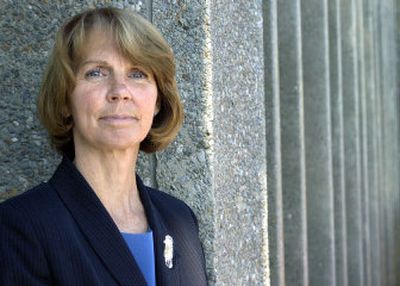She’s back from a land of the dead

Nearly six weeks after Hurricane Katrina ravaged the U.S. Gulf Coast, the slow task of collecting bodies continues in the town of St. Gabriel, La., where a team of private citizens from across the United States has gathered to identify and process victims of one of the nation’s worst natural disasters.
“They will still be finding bodies for some time to come,” said Dr. Sally Aiken, Spokane County’s chief medical examiner, who recently returned from two weeks’ duty in St. Gabriel, 70 miles north of New Orleans.
Aiken, a volunteer member of a federal Disaster Mortuary Operational Response Team, or DMORT, spoke about her experience in Louisiana at her office near Holy Family Hospital this week. She noted that authorities only last week allowed people back into New Orleans’ Ninth Ward, one of the city’s poorest districts.
“They expect to find more victims there,” Aiken said.
Last week, New Orleans Coroner Frank Minyard complained about how long it was taking the Federal Emergency Management Agency to identify victims as families waited for word about missing loved ones, according to news reports.
As of Monday, the Louisiana Department of Health and Hospitals reported that 1,021 bodies had been recovered, according to The Times-Picayune of New Orleans. Only 73 bodies had been publicly identified and returned to their families; 50 other bodies have been identified, but next of kin have not been notified.
Aiken, who has been Spokane County’s chief medical examiner since 2001, was first deployed at the request of Texas in support of Hurricane Rita relief efforts. After Rita blew through with minimal casualties, Texas disaster authorities permitted her to go to Louisiana to assist in that state’s victim recovery efforts, she said.
All the bodies recovered in Louisiana are taken to a warehouse in St. Gabriel, where one of the nation’s two Disaster Portable Morgue Units has been set up inside. Aiken slept on a cot in a nearby school, which has been converted to accommodate 150 DMORT specialists. The National Forest Service provided food, portable showers and other support services for the team.
Aiken’s job was to assess bodies as they came into the morgue and determine to what part of the system they would be sent. The bodies came to her two at a time, 70 to 80 a day, she said.
DMORT, under the auspices of FEMA, is assigned the task of providing temporary morgue facilities, victim identification, processing and disposition of remains.
The team members, acting as temporary federal employees, provide technical assistance to local authorities. They are funeral directors, medical examiners, pathologists, medical records experts, forensic odontologists, anthropologists, mental health experts, X-ray technicians, investigators and support staff. They are assisted by FBI fingerprint and DNA experts.
A temporary morgue similar to the one in St. Gabriel is operating in Gulfport, Miss.
The team’s task in Louisiana was monumental. Searching for the dead could not begin until authorities were confident the living had been rescued. Many bodies had been underwater for more than a week, according to reports. Often, facial features and even race was difficult to determine because of the advanced state of decomposition. Some bodies were found tied to street signs to prevent them from floating away. Searchers found many of the dead by doing door-to-door searches.
All team members were protected by full body coveralls called Tyvek suits.
Aiken, who worked at the direction of the coroner in charge, said she had no idea how many bodies she saw at the temporary morgue. It was the coroner’s job to determine cause of death, typically by drowning.
In most cases, Aiken said, the death certificates will read “disaster-related fatality.”
Aiken did not perform autopsies, though team members did assist local medical examiners in conducting autopsies on some bodies for legal reasons, particularly if a body came from a nursing home or hospital. She would not say whether she found gunshot wounds or other signs of violence on any of the bodies she examined.
After her daily assessments, Aiken would search a computer database for information collected from families of the missing for clues to a victim’s identity. A family assistance center, set up away from the temporary mortuary facility, collected information about physical characteristics of loved ones, including identifiable marks, surgical scars or tattoos, and personal effects, such as jewelry and eyewear.
While Aiken was away, Dr. Marco Ross, assistant medical examiner, covered her duties in Spokane. Aiken was accompanied to the Gulf Coast by Dustin Hegewald, a part-time investigator for the Spokane County medical examiner’s office. Hegewald worked as a “tracker,” a team member who escorts a body throughout the identification process.
Each body was handled with the greatest respect, Aiken said.
The pathologist said she did not see anything at the St. Gabriel facility she had not seen before, “but not on this scale.” She was moved by “the magnitude of this disaster,” she said. “It touched so many people.”
Each member of the team could not leave without a psychiatric evaluation to determine whether there were signs of post-traumatic stress.
“You have to separate yourself from the work,” Aiken said. “You have compassion for every single body you see and their families, but you have to be able to leave it at work.”
The morgue will be in operation for quite some time to come, she said. She and Hegewald are prepared to return if called upon to do so.